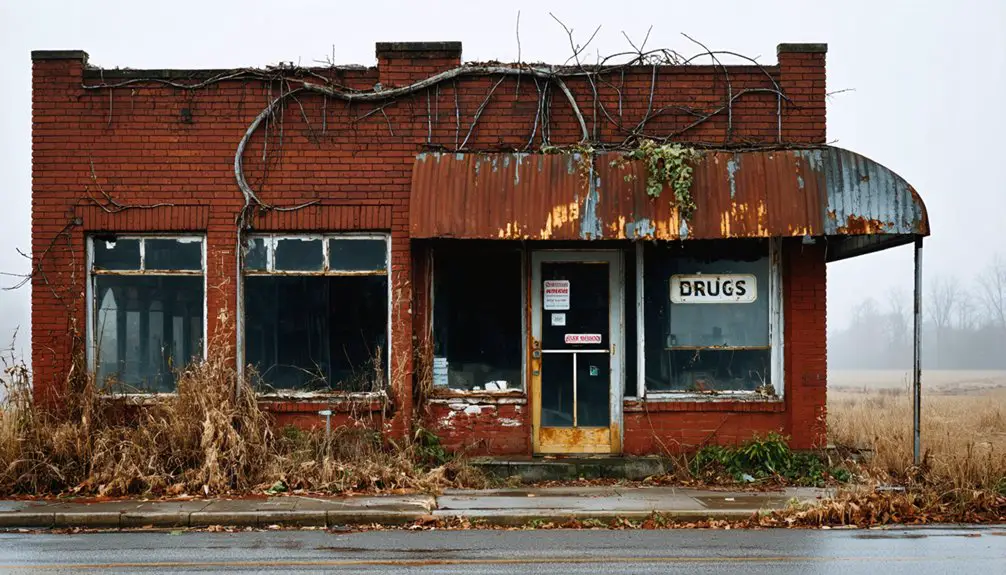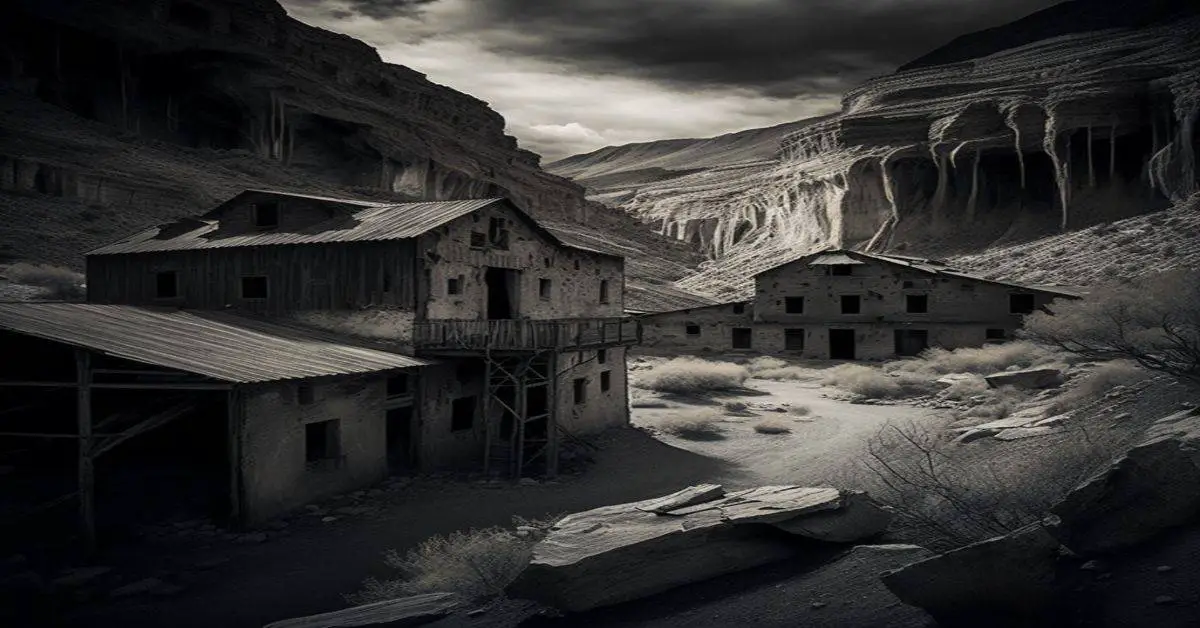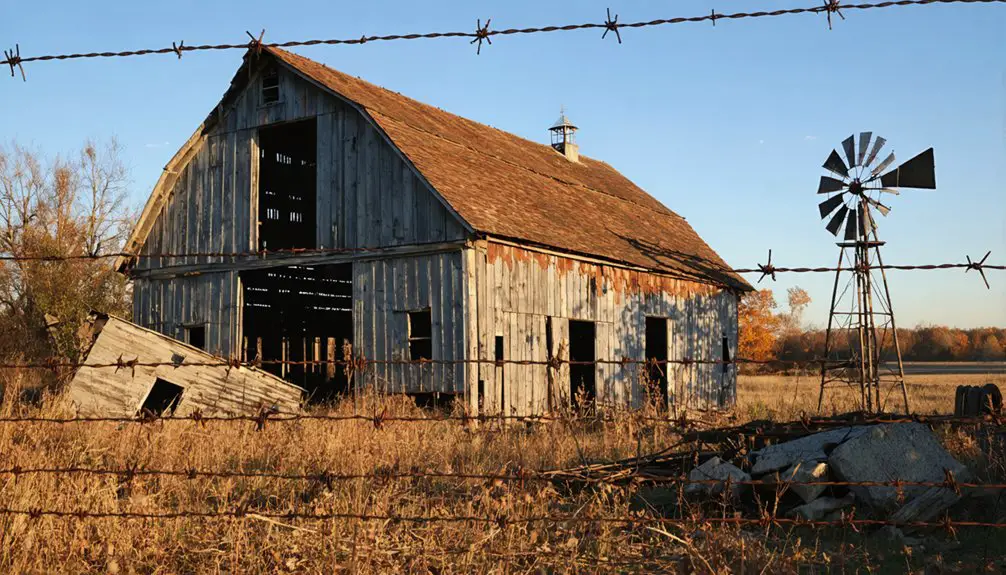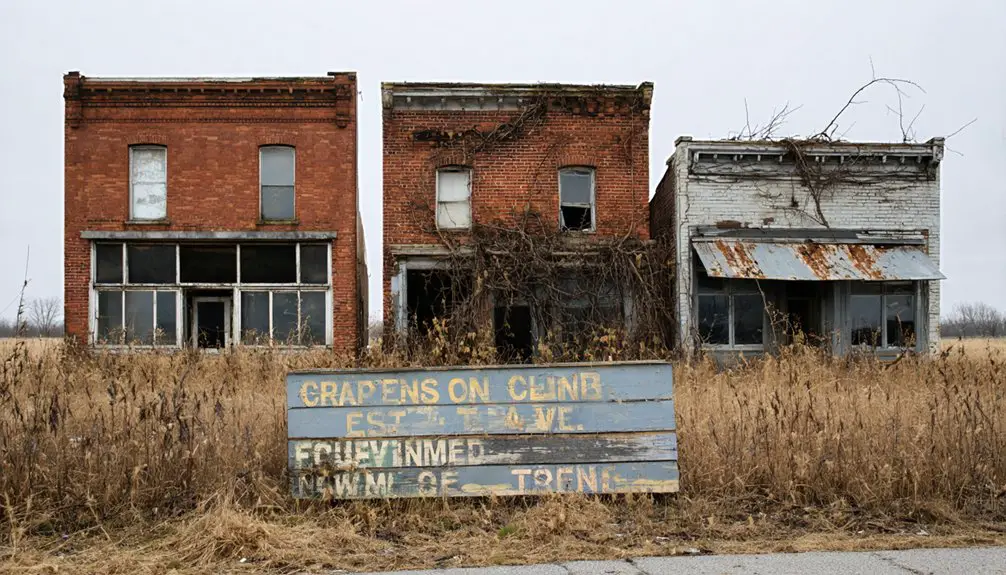You’ll find Oreton nestled along Ohio’s Route 160, where it once thrived as a bustling coal mining town in the Hanging Rock Iron Region. Established by the New York Coal Company, it boasted 70 company houses, a post office (1880-1950), and a company store run by Dave Ebert. The town’s fortunes faded when coal deposits ran dry in the early 1900s, leaving only scattered foundations and a brick safe to tell its tale. The crumbling ruins hold stories of America’s industrial heritage.
Key Takeaways
- Oreton was a thriving coal mining town in Ohio that became abandoned after mineral deposits were depleted in the early 1900s.
- Originally established by the New York Coal Company, the town featured 70 company houses and served a close-knit mining community.
- The town’s decline accelerated during the 1920s coal industry collapse, leading to widespread population exodus and eventual abandonment.
- The post office’s closure in 1950 marked a definitive end to Oreton’s status as an active community.
- Today, only ruins remain, including concrete foundations, a brick company store safe, and remnants of an iron furnace.
The Rise of a Mining Community
As coal mining surged across Ohio in the late 19th century, the New York Coal Company established Oreton, originally known as Aleshire, amid rich coal deposits that would help drive the state’s explosive growth in production.
You’d have witnessed remarkable community growth as mining operations accelerated through the 1850s, with Ohio’s coal output skyrocketing from 1 million to 40 million tons annually by the 1920s. The coal company provided housing and stores for workers and their families to sustain the growing community.
When profitable coal seams were discovered in 1884, families flocked to the area, drawn by the mining boom. Since multiple locations shared the name, Oreton became part of a group of geographic namesakes across different regions.
The town quickly took shape with essential infrastructure – about 70 company houses built by Bert Harder, a post office serving residents from 1880 to 1950, and even an iron furnace overseen by Samuel T. Benner, marking Oreton’s emergence as a thriving industrial hub.
Life in Oreton’s Glory Days
Life in Oreton during its heyday painted a vivid picture of America’s coal town culture, where some 70 company-built houses lined State Route 160 near the mines.
You’d find most homes constructed by Bert Harder, while Dave Ebert’s company store supplied your daily necessities.
Life centered around the mines’ demanding schedules, but you’d discover a tight-knit community where family traditions and church gatherings offered respite from the grueling work.
Despite long hours underground, miners found solace in their close community, where traditions and faith wove together their shared lives.
At the heart of social life stood the church, where Azariah McManis served as caretaker, hosting community events that brought mining families together.
Despite the challenges of mine work, you’d experience a strong sense of unity through shared experiences, from shift changes to Sunday services.
The town’s spirit thrived on these connections, even without its own cemetery.
The economic changes from reduced mining operations eventually led to the town’s decline, mirroring the fate of many similar communities.
Like many Ohio mining communities such as Moonville and Kings Station, the town depended heavily on the railroad for transportation and commerce.
Industrial Heritage and Economic Foundation
Deep in the heart of the Hanging Rock Iron Region, Oreton emerged as a mining powerhouse when the New York Coal Company established operations to exploit the area’s rich Clarion coal and Vanport limestone deposits.
You’ll find evidence of sophisticated mining techniques in the remnants of charcoal-fired blast furnaces and iron ore extraction sites that once fueled the town’s economic sustainability.
The industrial heritage that shaped Oreton’s identity included:
- A robust iron production facility producing over 100,000 tons annually during the Civil War era
- Strategic railroad connections via the Detroit, Toledo and Ironton line
- Company-built housing developments accommodating up to 70 mining families
- A vertically integrated economy centered around Dave Ebert’s company store
The co-location of coal and iron resources positioned Oreton as a crucial contributor to America’s 19th-century industrial growth. Like many operations in the region, the furnaces required approximately 1,200 bushels of charcoal each day to maintain production levels.
The Path to Abandonment
While the promise of coal and iron ore initially fueled Oreton’s prosperity, the town’s path to abandonment began in the early 1900s when accessible mineral deposits started running dry.
The remains of the Eagle iron furnace, now in ruins, stand as a testament to the town’s once-thriving industrial heritage.
You’ll find that economic factors hit hard as the nationwide coal boom collapsed in the 1920s, and America’s shift toward oil and natural gas further weakened demand for Oreton’s coal.
The population decline proved swift and merciless. With no alternative industries to sustain the community, miners and their families packed up and moved on.
The post office’s closure in 1950 marked a final turning point. Without permanent roots – not even a cemetery to anchor the community – Oreton’s residents scattered to the winds.
The town’s isolation along Route 160, far from major rail lines, left little hope for economic revival.
Remnants and Historical Legacy
As you explore Oreton today, the few tangible remnants tell a compelling story of its industrial past.
You’ll find the crumbling ruins of the iron furnace, scattered concrete foundations, and the brick safe from Dave Ebert’s company store – the most intact structure that’s survived time’s march. Just like Hope Furnace ruins nearby, these industrial remains paint a picture of Ohio’s iron production era.
While preservation efforts are limited, these ruins hold immense cultural significance as witnesses to Ohio’s mining heritage.
- The iron furnace ruins showcase the town’s industrial backbone, where Samuel T. Benner once supervised operations.
- Original road alignments along Route 160 trace the paths miners walked daily.
- The company store’s brick safe stands as a symbol of the town’s economic system.
- Concrete foundations map out where 70 houses, built by Bert Harder, once stood.
Frequently Asked Questions
Are There Any Paranormal Activities Reported in the Abandoned Ruins of Oreton?
You’ll find reported ghost sightings and spirit encounters there, but they’re mostly based on unverified local legends and social media claims, rather than documented evidence from paranormal investigations.
What Happened to the Families Who Lived in Oreton After Abandonment?
Moving masses migrated to surrounding towns, seeking new starts. You’ll find these families fled to Vinton County and nearby regions, maintaining community ties through churches while adapting to post-mining life.
Is It Legal to Visit and Explore Oreton’s Remaining Structures Today?
You’ll need to verify property ownership before exploring these ruins, as ghost town laws vary. Urban exploration here isn’t explicitly banned, but trespassing risks exist without clear public access rights.
Were There Any Major Accidents or Disasters in Oreton’s Mining Operations?
Like a blank page in history’s ledger, you won’t find documented major mining accidents or disaster reports from Oreton’s operations. Records suggest smaller-scale mining here avoided the catastrophic events seen elsewhere.
What Natural Wildlife Has Taken Over the Abandoned Town Site?
You’ll spot diverse wildlife sightings throughout the reclaimed site – from deer and coyotes to woodpeckers and hawks. Nature’s ecological impact has transformed the abandoned structures into thriving habitats.
References
- https://en.wikipedia.org/wiki/Oreton
- https://ohioghosttowns.org/top-10-ghost-towns/
- https://kids.kiddle.co/List_of_ghost_towns_in_Ohio
- https://www.youtube.com/watch?v=cb18QwuEmDo
- https://wrkr.com/ohio-ghost-towns/
- https://kb.osu.edu/server/api/core/bitstreams/cd2dbd16-eb3c-5690-bfeb-b24d0a004c88/content
- http://projects.thepostathens.com/SpecialProjects/ohios-hidden-history-ghost-towns-mining/
- https://dam.assets.ohio.gov/image/upload/ohiodnr.gov/documents/geology/B72_Crowell_1995.pdf
- https://www.midstory.org/the-remains-of-ohios-first-industrial-decline-are-hiding-in-its-forests/
- https://ohiodnr.gov/wps/portal/gov/odnr/go-and-do/plan-a-visit/find-a-property/belgian-coke-oven-ruins



